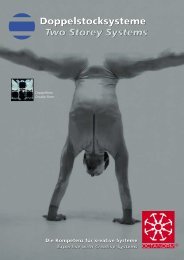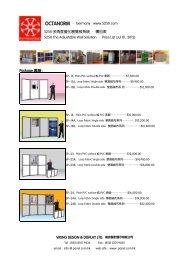Material
OCTANORM Image brochure 2 - panel.com.hk
OCTANORM Image brochure 2 - panel.com.hk
You also want an ePaper? Increase the reach of your titles
YUMPU automatically turns print PDFs into web optimized ePapers that Google loves.
Mr. Derrer, is it really very important to hire a<br />
lighting designer for a trade fair booth?<br />
Derrer: This is a question I asked myself only<br />
relatively late in my career, which I began by working<br />
for 10 years as a lighting designer. During that time,<br />
I did quite extensive research and developed<br />
professionally in the fields of opera, theatre and<br />
dance only. And even in these areas, the question as<br />
to whether or not you need to have lighting<br />
professionally done has not yet been satisfactorily<br />
answered – as is, unfortunately, all too evident in<br />
many cases.<br />
OCTANORM: What is special about professional<br />
lighting design?<br />
Derrer: My work in various artistic fields has taught<br />
me a great deal about the limitations and<br />
possibilities of lighting design. I’ve learned to work<br />
with space and time, form and style, composition<br />
and creation, attitude and emotion – plus I’ve become<br />
well versed in the technical tricks of the trade.<br />
OCTANORM: Are these factors significant for trade<br />
fairs as well?<br />
OCTANORM: What is the defining characteristic of<br />
lighting design?<br />
Derrer: Professional lighting should never be<br />
obtrusive. Even the differences between warm and<br />
cool colours can have a strong effect on visitors’<br />
somatic and emotional responses. Light can intensify<br />
and enhance the way a stand looks – or can ruin it<br />
completely. A »creative« lighting environment that is<br />
suitable for a given situation amounts to nothing<br />
more than a statement. However, if certain key data<br />
in visitors’ visual memory are stimulated in just the<br />
right way – thereby creating a significant experience<br />
for them – they will become more open to credulous<br />
enticement.<br />
OCTANORM: Do you see a trend towards lighting<br />
effects emerging at trade fairs?<br />
Derrer: The overwhelming megatrend is towards<br />
conditioning rooms – although that might sound a<br />
bit militarisitc. I am talking about a chill-out room<br />
whose purpose is to keep visitors from becoming<br />
overstressed by the complex sensory input of the<br />
event. These rooms are meant to be experienced<br />
Rolf Derrer is the owner of<br />
Delux Theatre Lighting of<br />
Zurich, Switzerland. The 50 yearold<br />
entrepreneur designs and<br />
produces light shows for fairs<br />
and cultural events. Among his<br />
most significant work is his<br />
collaborations with Peter Stein,<br />
director of the Berliner Schaubühne<br />
and with luminaries such<br />
as Bob Wilson. For his light<br />
shows, the city of Zurich<br />
awarded Derrer the coveted<br />
»Hans-Reinhart-Ring« prize. In<br />
the field of trade fair production,<br />
the companies he has<br />
worked with include Mercedes<br />
Benz (A-class tour, etc.) and<br />
O-tel-O (at Cebit in Hannover).<br />
Derrer: They certainly are. When I was first asked to<br />
design lighting (in 1993), many experts were predicting<br />
the imminent death of the conventional trade<br />
fair. It was said that CD-ROMS and the Internet<br />
would be able to make clearer images in the consumer’s<br />
mind of what was actually at the exhibition<br />
and thereby create a stronger bond with him or her.<br />
Perhaps it was precisely this fear of the death of the<br />
traditional trade fair that gave rise to novel kinds of<br />
productions and a new professionalism – at least for<br />
some exhibitors. Since then, exhibition stands have<br />
become more imaginative and user-friendly.<br />
quite naturally, and in a pleasant atmosphere. The<br />
act of walking through or entering the tunnel or<br />
channel is the most common form of this immersion<br />
experience, and that can be best achieved through<br />
the skillful deployment of light. These environments<br />
can even give rise to brief journeys through time.<br />
OCTANORM: Should indirect light be used?<br />
Derrer: Indirect lighting in a specific colour quality<br />
satisfies the need for understatement, and is an important<br />
affective factor.





